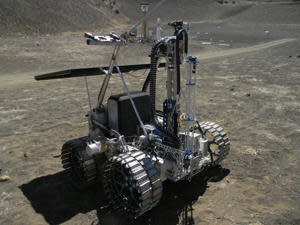 Science and Weather
Science and WeatherRobotic rovers may help put a Canadian on the Moon by 2030

Last October, the Canadian Space Agency rolled out several planetary rovers to show off their capabilities, and based on a new roadmap released by the International Space Exploration Coordination Group (ISECG) last week, this demonstration of robotics expertise may put a Canadian on the Moon by 2030.
The ISECG is a partnership of space agencies from 14 different nations around the world, and their Global Exploration Roadmap outlines a "common long-range human exploration strategy that begins with the [International Space Station] and expands human presence into the solar system, leading to human missions on the surface of Mars."
[ Related: Mars as big as the moon? Never going to happen, folks! ]
Although the next 10 years or so of their plans will keep us confined to low-Earth orbit, one of the stepping stones to Mars is to set up operations around and on the Moon. Perhaps starting in the early 2020s, the ISECG plan involves putting a new space station, which they call an 'evolvable Deep Space Habitat', at a point on the other side of the Moon called 'Earth Moon Lagrange Point 2'. There's a really cool video animation of the Earth Moon Lagrange Points here, that shows how anything put at this point would orbit around the Earth at exactly the same speed as the Moon.
From a station located there, astronauts would have unprecedented access to the lunar surface, and thus could easily travel there and back to conduct experiments or to construct habitats. Also, since they would always be within sight of the surface, they could pilot rovers on the moon without even leaving the station (similar to how astronauts on board the ISS recently did so with rovers on Earth). One of the rovers they have in mind for this is Artemis Jr. built by Canadian company Naptec Design Group Ltd to carry NASA's RESOLVE project to map out water and other useful resources on the Moon.
"We're proposing a vision where Canada could have an astronaut, effectively a Canadian who will be in lunar space, either in orbit or on the moon and could operate a Canadian rover in the same way that Canadians operate a Canadarm on the space station," said Jean-Claude Piedboeuf, the acting director of General Space Exploration at the Canadian Space Agency, in a Canadian Press interview. "We can foresee in the future doing the same type of thing on the moon, with the Canadian industry building a rover — and a Canadian astronaut could be the operator of this rover."
Canadian robotics expertise has opened the door to our being included in other space missions already. The Canadarm2 and Dextre (both now featured on our new $5 bill) have been in use on the International Space Station for years, following an extremely successful 'tour of duty' by the original Canadarm with NASA's Space Shuttle program. Also, Simon Engler, a robotics engineer from Calgary, just recently emerged from the four-month-long Hawaii Space Exploration Analogue & Simulation (HI-SEAS) experiment. While helping scientists figure out what foods astronauts might bring to Mars with them, he conducted his own research, involving robotic companions and the challenges faced by astronauts operating and repairing robot rovers while on other planets.
[ More Geekquinox: NASA’s Spitzer Space Telescope celebrates its 10th anniversary ]
So, for any young Canadians who are interested in robotics and human space exploration, this may be a great time to get started on a plan to become one of the first Canadians to set foot on the Moon. Who knows, in the next 10-15 years, you might end up driving this around on the lunar surface:
(Photos courtesy: Canadian Space Agency)
Geek out with the latest in science and weather.
Follow @ygeekquinox on Twitter!




